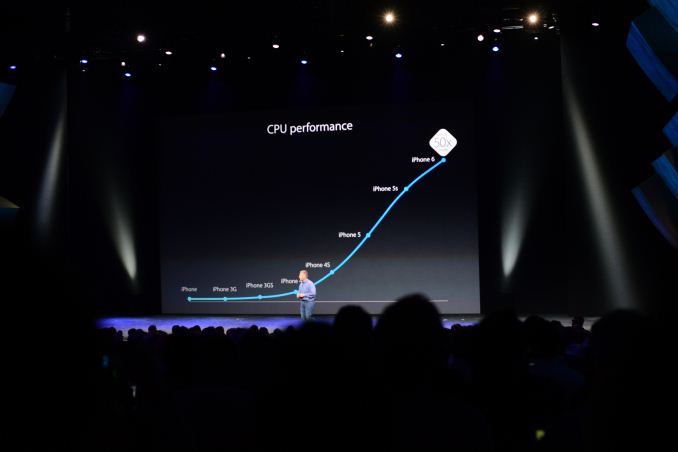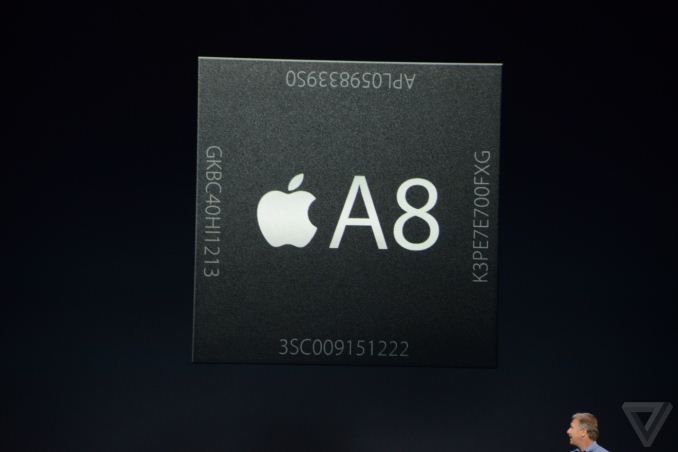Apple Announces A8 SoC
by Ryan Smith on September 9, 2014 1:45 PM EST
As expected from this year’s iPhone keynote, Apple has announced a new member of their internally developed family of ARM SoCs.
The latest SoC, dubbed A8, is Apple’s first SoC built on the 20nm process, and among the first SoCs overall to be built on this process. Apple notes that it has 2 billion transistors and is 13% smaller than the A7, which would give it upwards of twice as many transistors as the A7 and would put the die size at about 89mm2.

Image courtesy The Verge
From a performance perspective Apple is promising 25% faster CPU performance than A7. As is usually the case with Apple, they aren’t talking about the underlying CPU core – though this is a problem we’re working to rectify – so it remains to be seen how much of this is due to CPU architectural upgrades and how much is from clockspeed improvements afforded by the 20nm process. Apple just introduced their 64bit Cyclone core last year, so it stands to reason that just a year later and with the transition to 64bit already completed, A8 packs a CPU that is similar to Cyclone.
| Apple SoC Evolution | |||||
| CPU Perf | GPU Perf | Die Size | Transistors | Process | |
| A5 | ~13x | ~20x | 122m2 | <1B | 45nm |
| A6 | ~26x | ~34x | 97mm2 | <1B | 32nm |
| A7 | 40x | 56x | 102mm2 | >1B | 28nm |
| A8 | 50x | 84x | 89mm2 | ~2B | 20nm |
Meanwhile Apple is being even less specific about the GPU, but from their published baseline performance comparisons against the iPhone 1, the A8 is said to be 84x faster on graphics. This compares to a published figure of 56x for the A7, which implies that the A8’s GPU is 1.5x faster than the A7’s. Given Apple’s conservative stance on clockspeeds for power purposes and the die space gains from the 20nm process, it seems likely that Apple has upgraded from a 4 core PowerVR GPU to a 6 core PowerVR GPU, likely the flagship GX6650, which would account for the 50% performance gain right there.
Finally, Apple notes that the A8 is designed to be 50% more energy efficient than the A7. Some of these efficiency gains would come from gains due the 20nm process, however this large of a gain would indicate that Apple has done additional work at the architectural level to improve efficiency, as smaller manufacturing nodes alone do not see these kinds of gains.
Update: We have posted our initial A8 analysis here










66 Comments
View All Comments
lilmoe - Tuesday, September 9, 2014 - link
All of that supposed "power" coupled with 1GB of RAM.... Brilliant.Sorry, had to take a little jab at you for last time :P
gruffi - Wednesday, September 10, 2014 - link
A higher frequency design also needs transistors. For example if the routing is different or the pipeline has more stages. You are confusing it with overclocking. Which is a completely different story.And transistors can also be spend on non-performance features like power saving mechanisms. More cache can also lead to significant more transistors.
anderct - Monday, September 15, 2014 - link
no about 5% faster in actual real world experience ...kinda strange right ...well ...at least MIPS is taking risks ...and i assume a couple of us will go back and remember just how great MIPS actually is compared to ARMS licensing models.Laxaa - Tuesday, September 9, 2014 - link
I'm guessing it still has only 1GB of RAM. That's at least what the rumors point to.MikeMurphy - Tuesday, September 9, 2014 - link
They have to hold something back for the iPhone 6s.Wolfpup - Tuesday, September 9, 2014 - link
The iPhone 7 (ie 5s) SHOULD have had 4GB, the 5 (ie 5) SHOULD have had 2. It's utterly inane if this STILL only has 1GB.I find the new iPhones attractive and tempting...but I've had FOUR Lightning connectors fail on my now, most recently in my 5s, so I've switched to a Windows Phone + iPod combination for the time being.
mkozakewich - Tuesday, September 9, 2014 - link
'inane' means sort of pointlessly stupid. I think you meant 'insane', as in really kinda crazy.The thing is, more RAM uses more battery. I'm not sure how much, but my 4 GB Surface Pro's RAM will drain 15%-20% of my battery in a night.
Honestly, we need AnandTech to measure this kind of thing. How much is RAM? How much is leakage through the rest of the platform?
Also, 4 GB is about the least you can use, these days. In 2009, 1 GB was the least you would need. In another five years, will people be complaining when laptops only have 16 GB? One of the reasons Apple is keeping low amounts of RAM is that it forces developers to handle their resources better. There's no reason they should even need 1 GB, unless you're dealing with a game that has lots of texture resources.
lilmoe - Tuesday, September 9, 2014 - link
"more RAM uses more battery"First of all, the power consumption an extra 1GB of LPDDR3 is quite negligible (Android phones are living proof). In the iPhone's case, it's quite the opposite if you're going from 1GB to a *much needed* 2GB, since the amount of power you'll save when you don't have to reload every app or browser tab is far greater than what that extra GB would consume. That, and the fact that memory management is supposedly more efficient on iOS and thus RAM operations aren't as active as they would be on Android.
tipoo - Tuesday, September 9, 2014 - link
Just 20% faster (I think they said that, not 25)...If the RAM isn't doubled, that's hardly worth a SoC name iteration. Seems like that doubling single thread performance every year cadence has finally hit its wall. Quads with 6S I wonder?Infy2 - Tuesday, September 9, 2014 - link
The A7 core is probably already as wide as in Intel Core CPUs so getting more single thread performance is very difficult. Well you could make it wider but using it 100% for a single thread would be hard. That's why with Hyper threading in some cases you can inrease one core's performance nearly by 100% as the core has so many unused resources for a single thread alone.